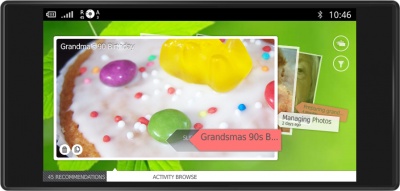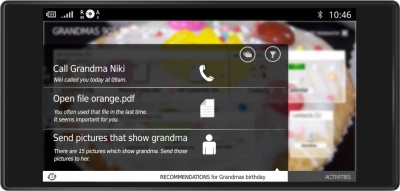Plasma/Active/Contour/Vision
Our Vision
Contour is part of Plasma Active, the new user experience for all kind of devices like tablet, Smartphone, automotive and others. Plasma Active uses existing free desktop technology and brings it to tablet devices through a touch-friendly and innovative user interface.
Contour will contribute to that vision with a new usage paradigm using adaptive activities and intelligent recommendations. The aim is to create a context-sensitive user interface that adapts to current context, current activities and behavioral patterns of the user.

Definition of Context
The context includes all the information that can be gathered from the sensors like:
- Current geo location
- Time
- Surrounding sounds
- Movement of the user
- Current activity
- Active files and applications
- Recent action history (conceptually the whole history can be taken into account - the further away an action is the less relevant it is)
Behavioral Patterns
- Behavioral patterns of the user like "every sunday evening at 18:00 the user calls their mother".
- Input for the patterns are the context and the actions the user takes.
- Patterns are dynamic in nature. They can change over time.
- Patterns can even be interrupted by location changes or other context changes and be picked up later (illness, vacation, ...).
- A pattern occurs if the same action is taken again and again in similar contexts. Similar here means that the contexts match with a high percentage.
Activities
- The activity is the static part of the user context.
- There is always exactly one current activity.
- Actions, applications and resources have a certain distance to an activity.
- Activities can be created or removed by the user. The system can suggest new activities when the user drasticly changes the way they normally use an activity. But the system will never create activities automatically.
- In addition each activity has a corresponding device configuration. For example the phone configuration includes simple things like ring tones, wallpapers as well as more complex rules like filtering incoming phone calls
Recommendations
- Recommendations are propositions for actions or information
- Dynamicly changing to context
- Based on the detected patterns (selflearning) and likes of the user (manually)
- Which activity is likely in which context?
- The relation between ressources (informationen, documents, applikations etc) and activities
- Can either be accepted or ignored by the user
Calculation of Recommendations
- User context
- Location
- Time
- Actions in proximity
- Usage statistics
- Resource scores
- Resource rank
- Resource distance
Examples of Recommendations
- Contact person X
- Open file Y
- Start playing music
- Take note about the phone call just received
- Open presentation for the meeting which you just entered
- The next bus to X goes in 10 minutes
Screenshots of User Interface




